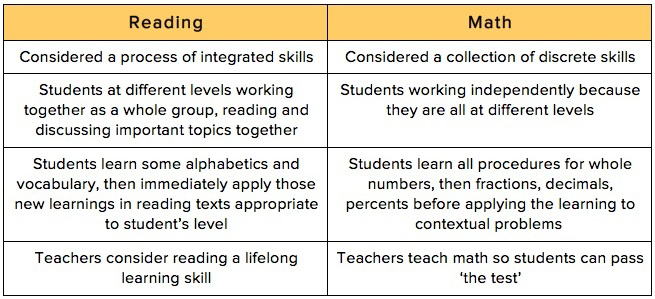Reading vs. Math
by Donna Curry
Math and reading are usually treated very differently in the classroom:
There is no reason that math should be taught in this way, especially if we want students who can reason, solve problems, and have mathematical discussions wherein they justify their thinking; no reason except that other models are not always readily available, so reverting to the familiar is easiest… and we don’t always know what is possible in a math class.
Math comprises an integrated set of skills, not a set of isolated skills. In our own lives, we never do a bunch of bare number problems (except in a math class); instead, we use a variety of math concepts and strategies (often in our head) to solve real-life problems, make predictions and decisions.
There is no reason to learn all the number facts before ever engaging in real-life situations, in the same way that students do not need to learn all phonics rules before trying to read a paragraph or story. In fact, students who are at the most basic level of instruction need to practice as much as possible to begin to build a solid foundation. What better way to practice than to use their learning in real-life situations on a daily basis?
To engage in interesting reading materials, teachers often simplify the text. Using shorter words and less complex sentences are two ways to adjust the difficulty of reading texts to make them more accessible to ABE students. Why can’t teachers simplify the numbers (changing fractions or decimals to whole numbers), or limit the amount of data to analyze, or suggest creating a bar chart instead of a circle graph? Why do teachers, for example, immediately expect students to calculate the exact percent when they see 5 out of 7 instead of asking students to think about whether 5/7 is more or less than 1/2?
We should think of computation like we do alphabetics. Both are important. But, just because a person can decode words does not mean that she can comprehend a passage. Likewise, just because a person can divide a fraction by a fraction does not mean she knows what it means, when to use the skill, or what to do with the result.
Teaching to the test is one goal in ABE. But, I wonder how many of us would suggest that math is only important for the test? We want to teach reading because it opens up the world for our adult learners. Math is just as prevalent in our lives – from the time we get up in the morning to the time we finish cooking dinner at night, our lives are driven by math concepts: using measurement, estimating, making decisions, thinking proportionately, applying geometry. There’s a whole world of math to explore. We should open it up, rather than close it for our students.
 Donna Curry is the Director of the SABES PD Center for Mathematics and Adult Numeracy, a project managed by the staff of the Adult Numeracy Center at TERC. She has trained teachers nationally, and has taught and administered ABE classes for over 30 years.
Donna Curry is the Director of the SABES PD Center for Mathematics and Adult Numeracy, a project managed by the staff of the Adult Numeracy Center at TERC. She has trained teachers nationally, and has taught and administered ABE classes for over 30 years.
